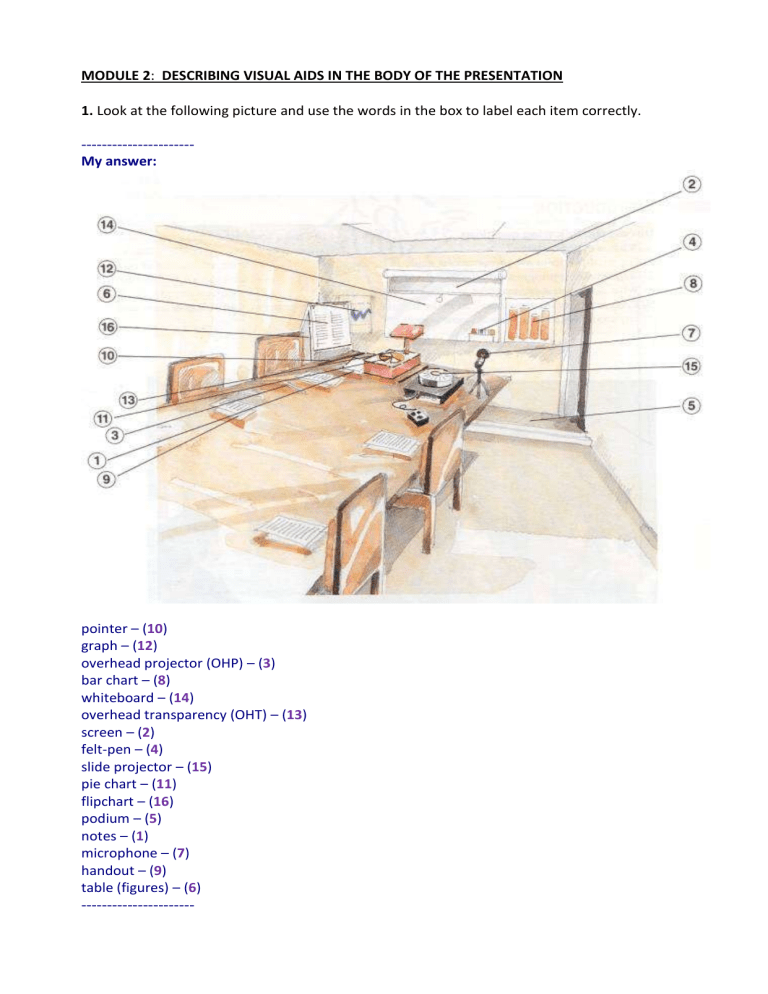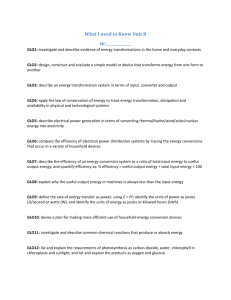vertical fossil

MODULE 2: DESCRIBING VISUAL AIDS IN THE BODY OF THE PRESENTATION
1. Look at the following picture and use the words in the box to label each item correctly.
----------------------
My answer: pointer – ( 10 ) graph – ( 12 ) overhead projector (OHP) – ( 3 ) bar chart – ( 8 ) whiteboard – ( 14 ) overhead transparency (OHT) – ( 13 ) screen – ( 2 ) felt-pen – ( 4 ) slide projector – ( 15 ) pie chart – ( 11 ) flipchart – ( 16 ) podium – ( 5 ) notes – ( 1 ) microphone – ( 7 ) handout – ( 9 ) table (figures) – ( 6 )
----------------------
2. Read the following abstract and summarize the main points.
----------------------
My answer:
Using visual aids the speaker should keep in mind that he is central to the presentation. A visual aid must support what he says but not replace the spoken information. It is not enough just to read what the visual says. The correct use of visual aids has many advantages. Visual aids “activate” another sense to receive information. They bring variety and therefore increase the audience’ attention to the presentation.
----------------------
4. Listening 1.
a. Listen to the description of the graph on the tape and complete the spaces in the following phrases.
----------------------
My answer:
1.
Now, I’d like to show you this graph. It shows the rate of increase in fossil fuel consumption since the mid-19 th century.
2.
On the left hand vertical axis you see fossil fuel consumption measured in giga tonnes of carbon, while the horizontal axis shows time in years. On the right hand axis you can see the three main types of fossil fuel: coal, oil and gas.
3.
What we can see here is, quite clearly, an extremely sharp rise in fossil fuel consumption and a trend towards more oil and gas.
(a) – to show you
(b) – shows
(c) – rate of increase
(d) – the left hand vertical axis
(e) – horizontal axis shows
(f) – right hand axis
(g) – can see
(h) – an extremely sharp rise
----------------------
b. Listen again and describe the following graph.
----------------------
My answer:
Now, I'd like to show you this graph. It shows the rate of increase in fossil fuel consumption since the mid-19 th century. On the left hand vertical axis you see fossil fuel consumption measured in giga tonnes of carbon per year, while the horizontal axis shows time in years from
1860 to 1985. On the right hand axis you can see the three main types of fossil fuel: coal, oil and natural gas. What we can see here is, quite clearly, an extremely sharp rise in fossil fuel consumption and a trend towards more oil and natural gas since the mid-20 th century.
----------------------
5. Practice.
Suggest an explanation for the information below in the form suggested above.
Fig.1. Relative consumption of fossil fuels.
Fig.2. Carbon dioxide emissions: major EU countries:
----------------------
My answer:
Now, I’d like to show you this pie chart. It shows the relative consumption of fossil fuels. Even though we are beginning to develop renewable energy resources they still provide only a small fraction (about 17%). Most of our energy (about 78%) comes from non-renewable fossil fuels, such as oil, natural gas and coal. Here we can see that oil leads both coal and natural gas; so we have 33%, 27% and 18%, respectively. The smallest consumption here is nuclear energy, only
5%.
Now, let’s take a look at this table. Here we can see the data on carbon dioxide emissions from the burning of fossil fuels in major EU countries. Here we have three columns reflecting the volume of CO2 emissions measured in million tonnes and produced by major EU countries from
1980 to 1989. The last row reflects the volumes of CO2 emissions produced by the whole
European Community. We can clearly see the increase in carbon dioxide emissions comparing
1986 and 1989 as well as the decrease in comparison with 1980 with the exception of the
United Kingdom and Italy. Only Germany has improved its pollution and CO2 emissions and is heading in this direction. One of the most important aspects of this is that we can change our behaviour to reduce our personal energy consumption. We must change our current live style and seriously strive for a sustainable living.
----------------------
6. Practice.
Imagine using the graph below in a presentation about air quality. Suggest how you would describe it. Use the prompts at a – d. a) “Now ……………………………..” b) “It shows …………………………..” c) “The vertical ……………………., while ……………..” d) “Clearly, we can see that ……………………”
----------------------
My answer:
Now, I’d like to show you this graph. It shows carbon dioxide emissions from the consumption of fossil fuels. The vertical axis shows trillions of tonnes per year while the horizontal axis shows time in years from 1985 to 2025. Clearly, we can see that CO2 emissions are rising at a great rate and according to preliminary figures will reach 8 trillions of tonnes by 2025. It is evident that the world-wide consumption of fossil fuels can’t be drastically reduced in the next
10 to 15 years. But we have to use the available energy much more efficiently to improve this situation.
----------------------
7. Practice.
Describe any visual aid (graph, table, pie chart, etc) using the key phrases listed below.
----------------------
My answer:
Log
0.00
10.00
vein zone
20.00
30.00
vein zone main vein zone vein zone
40.00
50.00
bleached/altered syenite red hematised syenite volcanic
Now, let’s take a look at this figure. Can everybody see that?
This figure represents summary log of top 55 meters of hole EXPL-1.
Here we can see the extent of quartz vein development (black bars) in relation to bleached syenite porphyry with obscure texture (yellow). Pink is red granular hematite syenite (not bleached). The upper altered zones have extensive ferrum oxide stained fractures and microbreccia veins. Note altered syenite on lower margin against the volcanic. This margin carries white extensional quartz veins (not epithermal).
One of the most important aspects of this is that it’s not yet clear if all syenites are pre-mineral.
Further logging is needed over whole Zone 1 deposit area.
----------------------






